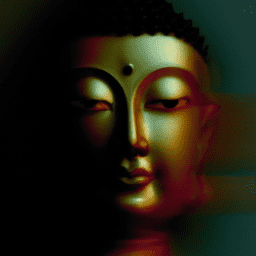9 Stages of resting the mind, Part I of 5
To meditate properly, you must understand what meditation actually is and internalize the proper form. The Buddha taught 9 stages of resting the mind. These lead to perfected meditation with strong application.
| 3 Areas | 6 Powers | 9 Stages | 5 Obstacles | 8 Antidotes | 3 Qualities | Experience |
|---|---|---|---|---|---|---|
| Hearing/ contemplating | 1: Placecement | Laziness Forgetting the instructions | Faith Aspiration Exertion Shinjang | Stability | Movement/ Waterfall |
|
| Preparation | 2: Continuous placement | |||||
| 3: Repeated Placement | Elation & Dullness | |||||
| Actual Meditation | Mindfulness Introspection/ Awareness | 4: Close Placement | Introspection / Awareness | Clarity | Attainment / Brook | |
| 5: Taming | Familiarity Slow River |
|||||
| 6: Pacifying | Power / Strength | |||||
| Exertion | 7: Thoroughly pacifying | Not applying antidotes | Applying antidotes | Stability / Calm Lake | ||
| Increasing Meditation | 8: One-pointedness | Overapplying antidotes | Resting in Equanimity | |||
| Thorough Familiarity | 9: Equanimity | Perfection/Mountain |
Table of Contents
How to Meditate Properly with the 9 Stages of resting the mind

To meditate properly, you need a workable definition of meditation. It must be useful to apply, easy to understand, and memorizable. You don’t want to look up your meditation definition repeatedly while you’re practicing.
To meditate properly at home for beginners requires a clear understanding of meditational theory and practice. The Buddha’s 9 Ways of Resting the Mind is the indispensable topic. Without a person to guide you, it can be a bit bewildering. This teaching will help orient you well. We’ll cover it in this series of posts.
Summary of terms for Meditation
Summary of Terms for Meditation
Here’s a possible knowledge graph for the term “Meditation”:
Center Node: Meditation
Concepts:
- Types of Meditation: Mindfulness Meditation, Vipassana Meditation, Zazen Meditation, Transcendental Meditation (TM), Loving-kindness Meditation (Metta), Guided Meditation
- Health Benefits: Stress Reduction, Anxiety Relief, Improved Focus, Emotional Regulation, Better Sleep, Pain Management, Increased Self-Awareness
- Practices: Breathwork, Focused Attention, Observing Thoughts and Emotions, Mantra Repetition, Yoga Postures
- Goals: Inner Peace, Spiritual Development, Enlightenment (in some traditions)
Relationships:
- **Meditation ** is a type of Mind-Body Practice
- **Meditation ** can improve Mental Health
- **Meditation ** is often used for Stress Reduction
- **Meditation ** has roots in Buddhism (but also practiced in Hinduism, Jainism, and other traditions)
- **Meditation ** can be practiced Individually or in a Group Setting
Additional Nodes:
- Brain (meditation can affect brain activity in areas related to focus and emotion regulation)
- Nervous System (meditation can help regulate the nervous system response to stress)
- Wellbeing (meditation can contribute to overall well-being)
Similar meaning:
- mindfulness
- contemplation
- reflection
- yoga
- breathwork
- relaxation
- inner peace
- focus
- concentration
- stillness
Related actions:
- practice
- sit
- breathe
- chant
- focus on
- observe
- detach from
- quiet the mind
Possible contexts:
- stress reduction
- anxiety relief
- spiritual development
- self-awareness
- improved focus
- emotional regulation
- better sleep
- pain management
- well-being
Antonyms:
- distraction
- agitation
- restlessness
- busyness
- overthinking
How to Meditate Properly PDF
What is Meditation?
Meditation is the process of resting the mind on an object and leaving it there.
That’s the main instruction. Internalize it, do not forget it, and allow it to be a non-conceptual habit – an experienced situation rather than an idea. Kind of like driving. You don’t need to think about it. Ultimately, this leads to YOGA – union. The mind and the object unite inseparably.
Of course, we need to explain these terms.
The process means that meditation is an activity. This counters the tendency to see meditation as passive. I work closely with mind in meditation as a reflex.
Resting means to not move the focus. Concentration remains on the object. Otherwise it is not meditating properly. Essentially, the focus remaining on the object IS the defining characteristic of meditation.



The mind is the consciousness in this case. This is an incredibly complex topic, but for the purposes here, the idea of the particular aspect of consciousness called mindfulness or focus, will be the best starting place.
The object of meditation is whatever the mind focuses on. That object can be a physical object, such as a stick or a buddha statue, or an aspect of the body like the breath, or a visualized object, such as a deity.
Leaving the mind there means it does not wander. The forcing of the placement varies, depending on the skill level. At first, it is tedious and a bit tight, later it becomes very open and relaxed and the mind will remain without effort.
With this definition in mind, let’s look into the many aspects of meditation.
How to meditate like a yogi
and enter profound samadhi
9 Stages of Resting the Mind
The nine stages of shamatha meditation is a progressive training in deepening
calm abiding meditation using innate abilities of the mind. These include listening, contemplating, mindfulness, introspection, exertion and familiarization. This creates the ability to increase concentration and deepen focus on the object. Here is the list.
- Placement
- Continuous Placement
- Repeated Placement
- Close Placement
- Taming
- Pacifying
- Thoroughly Pacifying
- One-Pointedness
- Equanimity
I’ll go over the details of these in the rest of this article. This map is the method to increase shamatha, or calm abiding. But what is Calm Abiding?
Calm Abiding Meaning
Calm abiding means to settle the mind clearly on the object without it being pulled away by thoughts and mental events. Shamatha is the sanskrit term for calm abiding. In Tibetan it is called Shiné, or dwelling in peace. The other Tibetan term is Gom, for meditation. Gom means to become accustomed to. And that’s what meditation is – becoming accustomed to something.
In order to do that, you need to let the mind settle, to abide calmly. That process happens as the 9 stages, each one deepening the state. But it’s not easy, there are 5 sequential obstacles. These are universal to everybody as they learn.
obstacles to meditation:
- Laziness
- Forgetting the Instructions
- Excitement / torpor
- Not applying the antidotes
- Overapplying the antidotes
Eight antidotes are applied against the five obstacles in order to deepen the 3 qualities: meditative stability, meditative clarity, and meditative strength or power.
Eight antidotes to meditative obstacles
- Faith
- Aspiration
- Exertion
- Shinjang
- Remembering the Instructions
- Introspection / Awareness
- Applying the Antidotes
- Equanimity
The nine stages are generally divided into three areas.
Preparation is the first three stages.
Actual meditation and increasing meditation proper is stages four to seven. This is how to meditate properly.
Deepening meditation is stages seven to nine.
Preparing to Meditate
It’s important to assess where we are in the path of meditation.
Before preparation, we’ll start with shamatha which is inherent to the mind. Shamatha is essentially strongly developed mindfulness. In its most succinct formulation meditation is summed up as
Place the mind on the object of meditation and let it remain there without moving.
Indespensible Instruction of Meditation
If someone can legitimately do that, then they don’t need further instruction. However, there are whole volumes written just on shamatha. Therefore, it’s necessary to deal with the obstacles that come up in meditation, mainly one’s own mental distractions, but also external distractions in the environment.
Mindfulness is inherent. The intensity of the mind can concentrate on anything. It can concentrate on one’s name, cooking dinner, checking emails, whatever it is. The mind is capable of doing that.
That ability to do those things is called mindfulness, and that is the capacity that
we are strengthening in the nine stages of training the mind.
3 Characteristics of Medition
Shamatha meditation develops through three distinct qualities:
- Stability
- Clarity
- Power
The first quality we’re developing is stability, the ability of the mind to remain on the object.
The second is clarity or vividness, the detail and precision with which the object is meditated
upon. And the third is power, the amount of focus brought to the object, the ability to penetrate it, to totally absorb into the object. When vipassana is engaged we can understand its essence. However, that will not be the subject of this presentation.
Vipassana is difficult to sustain
The nine stages strictly focus on shamatha. Once strong shamatha is accomplished
and we’re at some sense of power, then vipassana can be engaged. The reason not to engage vipassana or meditation and insight too early is because it’s a much more difficult object of meditation to sustain. Therefore, it’s important to increase the simple power of shamatha before engaging in this more difficult and abstract object. Otherwise, the mind simply will not be able to remain on the object.
The Powers of Meditation
The mind has six innate powers that are being developed and strengthened through meditation. To be more precise, the first two powers are ways to strengthen meditation and the others are developed through meditation.
- Hearing and contemplation
- Mindfulness
- Awareness
- Introspection
- Exertion
- Thorough Familiarity
Hearing is reading or listening to some teachings in the Dharma. In the case of this presentation, it would be learning the nine stages, six powers, obstacles, and antidotes,
three qualities, and so on. And knowing, just learning the basic terminology and how it fits together by studying the chart.
Contemplation is coming to a deeper understanding material, learning how to identify what stage of meditation you might be at, what stage to apply antidotes, what laziness and its antidote really, contemplating it and trying to see it in your life. Learn what the antidotes of faith and aspiration, effort, and shinjang really mean, and how you use them to overcome laziness. Learn what the quality of stability means and having some idea or concept of how it might be experienced in meditation.
The next Power is mindfulness, which is the innate power of the mind to focus, the ability of the mind to remain on the object.
3 qualities of mindfulness
- Familiarity
- Not Forgetting
- Not Moving
The first aspect of mindfulness: familiarity, means mind knows what the object is. It can be introduced to the object and it can get used to it. In this case, it’s the object of meditation. Generally, we’ll be using the breathing in this discussion of the nine stages as the object of meditation.
With familiarity, at first one simply looks at the object, asks “what is the breath?” First it’s just a word, but true introduction means that mind can experience the breath as it is. It’s slowly turned into familiarity, becoming more and more comfortable with the object. It’s not strange, it’s not uncertain.
The second quality of mindfulness is not forgetting. The mind knows what its object is. We think we know the breath, but if we haven’t really meditated on it and looked at it, it’s always just been in the background. It’s a subconscious thing. Do we really know it? Well, that’s the process here: getting used to it, getting accustomed to it in terms of directly looking at it. Familiarity is knowing the object, knowing it very clearly, knowing it more and more intimately, really understanding what it is.
The breath is surprisingly complex and nuanced once meditation begins. There
aren’t many ways to do shamatha. But there are many, almost infinite, objects of shamatha that could be chosen. They all come down, of course, to developing mindfulness.
Benefits of Meditation on Breathing
One of the reasons the breath is an object of meditation is because it tames both discursiveness and intense emotionality. It has a quality of settling and stabilizing, and at the same time not being tight and fixated because it’s constantly flowing. When you breathe out, you can constantly release the thoughts, release the intensity, and release the emotional excesses. What’s left is just the mind and it’s called the natural state.
The final aspect of mindfulness is not forgetting. The object of meditation is remembered. If you’re meditating on the breathing and somebody said, what are you meditating on? You would say the breath immediately. You wouldn’t need a second
to think. When mindfulness on the object is present, then the object is in the mind stream.
The third aspect of mindfulness is not moving or one-pointedness. The mind is solidly on the object. It’s not subtly wandering into thoughts. It’s focused. It’s concentrated. It’s not dispersed.
These three elements of mindfulness are necessary to have proper mindfulness in meditation. Proper mindfulness is necessary for genuine meditation. Without mindfulness, it is not meditation. Since this is the bad news, there is work to do and it’s not pleasant. It’s not easy. It’s difficult.
Conclusion
I haven’t gotten to the first stage yet, but don’t worry. It’s the next part. This long series forms a strong primer to meditate properly. If you want to meditate well, this is the teaching the Buddha gave. It takes effort and application to be strong in meditation. It is well worth the effort, however.
Part II How to meditate correctly
faq
How do you know if your meditating correctly?
You know if you are meditating correctly when the mind remains focused on the object of meditation.
How do beginners start meditating?
Beginners start meditating ideally by studying the concept of meditation. You cannot meditate properly if you do not understand meditation.
What to think about while meditating?
While meditating, think about as little as possible. Do not suppress thoughts, but do not indulge them. Think about improving meditation and aspire to do so.
What are the 7 steps of meditation?
The 7 steps of meditation are better thought of as the 9 stages of meditation.
What are common mistakes in meditation?
The most common mistake in meditation is not knowing what meditation actually is. The second most common is lack of effort in sustaining mindfulness.
Can I meditate lying down?
You technically can meditate while lying down, but it is much more difficult to maintain mindfulness on an object, so it is recommended to sit up.
How do I stop thinking when meditating?
You stop thinking while meditating by focusing the entirety of mind’s attention on the object. One-pointedness will largely arrest thoughts. The few that still come are easily dealt with.
How do I clear my mind while meditating?
To clear the mind while meditating, you should make a sincere effort to focus the mind on the object. Mind will naturally clarify by becoming absorbed on a particular meditative object, such as the breath.
How to meditate for anxiety?
You meditate for anxiety by knowing anxiety is a thought and releasing the concept of anxiety. Then let the energy be or reframe it.

May all beings be happy
May all beings be peaceful
May all beings be safe
May all beings awaken to the light of their true nature
May all beings be free







